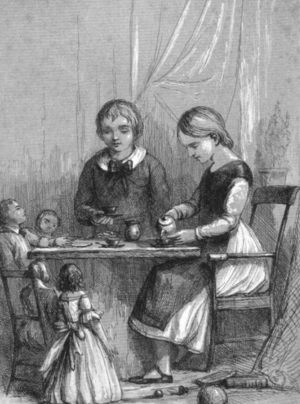Anna Mary Howitt facts for kids
Quick facts for kids
Anna Mary Howitt
|
|
|---|---|

by Rossetti c. 1853
|
|
| Born | 15 January 1824 |
| Died | 23 July 1884 Dietenheim
|
| Nationality | United Kingdom of Great Britain and Ireland |
| Education | Henry Sass's Art Academy |
| Spouse(s) | Alaric Alfred Watts |
| Parent(s) | William Howitt (1792–1879) and Mary Botham |
Anna Mary Howitt (who later became Anna Mary Watts after marriage) was a talented English artist and writer. She was born on January 15, 1824, and passed away on July 23, 1884. Anna was part of the Pre-Raphaelite art movement. She was also a strong supporter of women's rights and explored spiritual ideas. After a health issue in 1856, she stopped showing her art in public. Instead, she became known for "automatic drawing," a unique way of creating art.
Contents
Anna Mary Howitt: Artist and Writer
Anna Mary Howitt was born in Nottingham, England. She was the oldest child of William Howitt and Mary Botham. Both of her parents were writers and publishers. Anna spent much of her childhood in Esher. When she was a teenager, her family moved to Heidelberg, Germany. They believed Germany offered better schools for her.
Becoming an Artist
Anna showed artistic talent from a young age. In 1846, she joined Henry Sass's Art Academy in London. There, she studied alongside famous artists like William Holman Hunt and Dante Gabriel Rossetti. In 1847, she drew pictures for her mother's book, The Children's Year.
In 1850, Anna traveled to Munich with her friend, artist Jane Benham. She studied art there with Wilhelm von Kaulbach. Anna started writing articles about Munich. These articles were later put together into a book called An Art-Student in Munich (1853). Her stories and drawings also appeared in the Illustrated Magazine of Art.
Her book, An Art-Student in Munich, was very popular. The New York Times said it was a "sunny work" that left a "luminous trail" in the reader's memory. Anna was connected to two important groups at this time. One was her parents' literary circle in London. The other was a group of modern, feminist women her own age.
Supporting Women's Rights
Anna was close friends with Barbara Leigh Smith, a leading feminist. They were part of the Langham Place feminists. Anna first showed her art at the National Institution of Fine Arts in 1854. Her painting was inspired by Goethe's Faust.
In 1856, Anna helped Barbara Leigh Smith gather signatures for a petition. This petition helped lead to the Married Women's Property Act 1870. This law was very important for giving married women more rights over their own money and property.
Anna faced some challenges with her art. A famous art critic, John Ruskin, criticized her large painting of Boadicea. The Royal Academy also rejected it. This might have made her decide to step back from the professional art world. She later wrote about a health event that changed her path.
Anna Mary Howitt: Writer and Spiritualist
In 1859, Anna married Alaric Alfred Watts, a childhood friend. He also shared her interest in spiritualism. They later moved to Cheyne Walk in Chelsea. Their home was just a few doors away from Dante Gabriel Rossetti.
Anna continued to write and publish often. She wrote mostly for spiritualist newspapers and magazines. With her husband, she wrote a book of poems called Aurora: a Volume of Verse (1884). Her book Pioneers of the Spiritual Reformation (1883) included stories about her father, William Howitt.
Anna stayed close to her brother, Alfred William Howitt. He had moved to Australia and became an explorer. Anna helped him from England. She found equipment for him, checked his writings, and kept him connected to academic groups.
Spirit Drawings
Many of Anna Mary Howitt's "spirit drawings" still exist today. These are drawings she created without her conscious control. They are kept in archives at Cambridge University Library and the College of Psychic Studies in London. Anna's work inspired other artists like Georgiana Houghton. Today, her drawings are getting more attention from art experts.
Anna's family knew the famous novelist Charles Dickens. He even gave her advice on her writing.
Anna Mary Watts passed away in 1884 from diphtheria. She was visiting her mother in Tyrol (which is now part of Italy) at the time.
External resources
- Rachel Oberter, Spiritualism and the Visual Imagination in Victorian Britain, PhD dissertation, Yale University, 2007
- Black-and-white reproduction of AMH's 1849 portrait of fellow artist John Banvard (1815–1891): Retrieved 9 July 2011.
- The text of An Art-Student in Munich online: Retrieved 9 July 2011.
- The text of The Children's Year by Mary Howitt, illustrated by her daughter Anna Mary Howitt: Retrieved 9 July 2011.
- A chapter on Anna Mary Howitt's travels in Munich in Heidi Liedke: The Experience of Idling in Victorian Travel Texts, 1850–1901. Palgrave Macmillan, 2018 Retrieved 17 August 2018.


